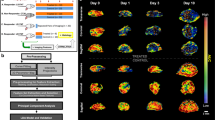Abstract
Dynamic contrast-enhanced ultrasonography (DCE-US) using a second-generation contrast agent and perfusion software is a new technique enabling a quantitative assessment of solid tumor perfusion using raw linear data. Clinical trials have shown that it can be used to assess the anticancer efficacy of antiangiogenesis treatment, for which conventional, size-based efficacy criteria are unsuitable. Reduction in tumor vascularization can easily be detected in responders after 1 or 2 weeks and is correlated with progression-free survival and overall survival. DCE-US is supported by the French National Cancer Institute (INCa), which is currently studying the technique in metastatic breast cancer, melanoma, colon cancer, gastrointestinal stromal tumors and renal cell carcinoma, as well as in primary hepatocellular carcinoma, to establish the optimal perfusion parameters and timing for quantitative anticancer efficacy assessments.



Similar content being viewed by others
References
Rehman S, Jayson GC (2005) Molecular imaging of antiangiogenic agents. Oncologist 10:92–103
Schwartz L (2005) Imaging in drug discovery: emerging roles and challenges. In: Plenary session, RSNA Program, Chicago, IL, 27 November–2 December 2005, p 35
Benjamin R (2006) Response of gastrointestinal stromal tumors to imatinib by Choi criteria and response evaluation criteria in solid tumors (RECIST) as surrogates for survival and time to progression. J Clin Oncol 24(18S):9506
Cosgrove D (2003) Angiogenesis imaging—ultrasound. Br J Radiol 76:S43–S49
Lassau N, Koscielny S, Opolon P, De Baere T, Peronneau P, Leclere J, Roche A (2001) Evaluation of contrast-enhanced color Doppler ultrasound for the quantification of angiogenesis in vivo. Invest Radiol 36:50–55
Escudier B, Lassau N, Couanet D, Angevin E, Mesrati F, Leborgne S et al (2002) Phase II trial of thalidomide in renal cell carcinoma. Ann Oncol 13:1029–1035
Greis C (2004) Technology overview: Sonovue (Bracco, Milan). Eur Radiol 14(Suppl 8):P11–P15
Lassau N, Lamuraglia M, Vanel D, Le Cesne A, Chami L, Jaziri S et al (2005) Doppler US with perfusion software and contrast medium injection in the early evaluation of isolated limb perfusion of limb sarcomas: prospective study of 49 cases. Ann Oncol 16:1054–1060
Lassau N, Lamuraglia M, Chami L, Leclère J, Bonvalot S, Terrier P et al (2006) Gastrointestinal stromal tumors treated with imatinib: monitoring response with contrast-enhanced sonography. Am J Roentgenol 187:1267–1273
Lamuraglia M, Escudier B, Chami L, Schwartz B, Leclère J, Roche A, Lassau N (2006) To predict progression-free survival and overall survival in metastatic renal cancer treated with sorafenib: pilot study using dynamic contrast-enhanced Doppler ultrasound. Eur J Cancer 42:2472–2479
Escudier B, Lassau N, Angevin E, Soria JC, Chami L, Lamuraglia M, Zafarana E et al (2007) Phase I trial of sorafenib in combination with IFN alpha-2a in patients with unresectable and/or metastatic renal cell carcinoma or malignant melanoma. Clin Cancer Res 13:1801–1809
Blay JY, Landi B, Bonvalot S, Monges G, Ray-Coquard I, Duffaud F et al (2005) Recommendations for the management of GIST patients. Bull Cancer 92:907–918
Choi H, Faria S, Benjamin R, Podoloff D, Macapinlac H, Charnsangavej C et al (2002) Monitoring treatment effects of STI-571 on gastrointestinal stromal tumors (GIS) with CT and PET: a quantitative analysis. Proceedings of the RSNA Scientific Program, Chicago, IL, p 583
De Giorgi U, Aliberti C, Benea G, Conti M, Marangolo M (2005) Effect of angiosonography to monitor response during imatinib treatment in patients with metastatic gastrointestinal stromal tumors. Clin Cancer Res 11:6171–6176
Le Cesne A, Landi B, Bonvalot S, Monges G, Ray-Coquard I, Duffaud F et al (2005) Recommandations pour la prise en charge des tumeurs stromales gastro-intestinales. Hepato-Gastro 12:377–389
Lamuraglia M, Le Cesne A, Chami L, Bonvalot S, Terrier P, Tursz T, Roche A, Lassau N (2006) Dynamic contrast-enhanced Doppler ultrasound (DCE-US) is a useful radiological assessment to early predict the outcome of patients with gastrointestinal stromal tumors (GIST) treated with imatinib (IM). J Clin Oncol 24(18S):9539
Le Cesne A, Landi B, Bonvalot S, Monges G, Ray-Coquard I, Duffaud F, Bui B, Nguyen B, Bugat R, Chayvialle JA, Rougier P, Bouche O, Bonichon F, Lassau N, Vanel D, Nordlinger B, Stoeckle E, Meeus P, Coindre JM, Scoazec JY, Emile JF, Ranchere D, Blay JY (2006) Recommendations for the management of gastro-intestinal stromal tumors. Ann Pathol 26(3):231–234
Kaelin WG (2002) Molecular basis of the VHL hereditary cancer syndrome. Nat Rev Cancer 2:673–682
Therasse P, Arbuck SG, Eisenhauer EA, Wanders J, Kaplan RS, Rubinstein L et al (2000) New guidelines to evaluate the response to treatment in solid tumors. European Organization for Research and Treatment of Cancer, National Cancer Institute of the United States, National Cancer Institute of Canada. J Natl Cancer Inst 92:205–216
McCarville MB, Streck CJ, Dickson PV, Li CS, Nathwani AC, Davidoff AM (2006) Angiogenesis inhibitors in a murine neuroblastoma model: quantitative assessment of intratumoral blood flow with contrast-enhanced gray-scale US. Radiology 240:73–81
Kruskal JB (2006) Science to practice: will improved assessment of response to antiangiogenic therapies be achieved with contrast-enhanced gray-scale US. Radiology 240:1–2
Soria JC, Lazar V, Lassau N, Pena C, Massard C, Robert C, Koscielny S, Deutsch E, Zafarana E, Armand JP (2007) Sorafenib (S) and dacarbazine (D) combination in patients with advanced malignant solid tumors: phase I study with tumor biopsy genomic analysis and dynamic contrast enhanced ultrasonography (DCE-US). J Clin Oncol 25(18S):3556
Lassau N, Chami L, Peronneau P (2007) Imaging of melanoma: accuracy of ultrasonography before and after contrast injection for diagnostic and early evaluation of treatment. Bull Cancer 94:93–98
Conflict of interest statement
No funds were received to support this article.
Author information
Authors and Affiliations
Corresponding author
Rights and permissions
About this article
Cite this article
Lassau, N., Chebil, M., Chami, L. et al. A new functional imaging technique for the early functional evaluation of antiangiogenic treatment: dynamic contrast-enhanced ultrasonography (DCE-US). Targ Oncol 3, 111–117 (2008). https://doi.org/10.1007/s11523-008-0081-x
Received:
Accepted:
Published:
Issue Date:
DOI: https://doi.org/10.1007/s11523-008-0081-x




